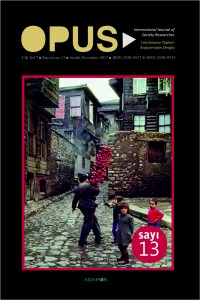Abstract
Rural areas are multifaceted
places that are based on farming, have face-to-face relationships, involving a
social structure which have undeveloped division of labor and specialization,
and are important for the protection of cultural and natural values. In this
context, while identification and analysis of rural identities and values are
important, they also form the basis for local and regional studies. In this
study; in order to determine the local values at the village level and to
identify the rural area identity, 10 village settlements representing the
region in which they are located(Bayburt) have been analyzed in terms of
natural-cultural landscape values, traditional-modern architectural elements
and settlement patterns. With data collection, observation studies and
individual interviews carried out in the study, natural and cultural values,
characteristics of identity were put forward and the dominant landscape
characters of the area were determined and evaluated. In general, apart from
intra-village transportation and landscape, there are no major problems in
infrastructure systems.In the rural areas of this province, north-south and
east-west lines are the scene of visual changes. The changes that occur with
the mystery of a settlement located in high sections among the trees and the
transparency of a village spread over the ovary are tempting. The most striking
feature of the mentioned rural settlements is that they do not have an
effective architectural character. In addition, most of the villages have a
mosque in the center and a village square which is usually formed around the
mosque.
Keywords
References
- Arıcı, İ., (1982). Kırsal toplu yerleşimler ve işletme avlularının düzenlenmesi. Atatürk Üniversitesi, Ziraat Fakültesi Ziraat Dergisi, 13(3-4), 173, Erzurum.
- Aydemir, E., (2010). Yöresel mimari ve kırsal dokunun korunması: Artvin, Şavşat, balıklı mahallesi örneği. Yüksek Lisans Tezi, İTÜ Fen Bilimleri Enstitüsü, İstanbul.
- Çubuk, M., (1985). Türkiye'de kentleşme süreci ve kırsal alan sorunları kolokyumu. Dünya Şehircilik Günü Kolokyumları II, MSÜ Fen Bi-limleri Enstitüsü Yayınları.
- Dirik, H., (2005). Kırsal peyzaj (planlama ve uygulama ilkeleri). İstanbul: İstanbul Üniversitesi Orman Fakültesi Yayın No:4559-486.
- Erdem, M., (2012). Kırsal yerleşim peyzaj kimlik özelliklerinin tespiti, korunması ve geliştirilmesine yönelik değerlendirme matisi önerisi. İstanbul Teknik Üniversitesi, Fen Bilimleri Enstitüsü, Doktora Tezi, İstanbul.
- Gallent, N., Juntti, M., Kidd, S., Shaw, D., (2008). Introduction to rural planning. Routledge, Taylor and Francis Group.
- Koç, N., Şahin, Ş., (1999). Kırsal peyzaj planlaması. Ankara: Ankara üniversitesi Ziraat Fakültesi Yayın No: 1509(463).
- Mucher, C. A., Klijn J. A., Wascher D. M., Schamine J. H.J., (2010). A new European Landscape Classification (LANMAP): A transparent, flexible and user-oriented methodology to distinguish landscapes. Ecological Indicators, 10,87–103.
- Neuman, M., (2000). Regional design: Recovering a great landscape architecture and urban planning tradition. Landscape and Urban Planning, 47, 115-128.
- Tempesta, T., (2010). The perception of agrarian historical landscapes: A study of the Veneto plain in Italy. Landscape and Urban Planning 97, 258–272.
Abstract
Kırsal alanlar, ekonomisi
tarıma dayanan, yüz yüze ilişkilerin yaygın olduğu, işbölümü ve uzmanlaşmanın
gelişmediği toplumsal ortamlarda yaşayan insan topluluklarını içeren, kültürel
desenin ve doğal değerlerin korunması açısından önem taşıyan çok yönlü mekanlardır.
Bu bağlamda, kırsal kimliğin ve değerlerin tespiti ve analizi de önem teşkil
ederken, yerel ve bölgesel çalışmalar açısından temel oluşturmaktadır. Bu
çalışmada; köy ölçeğinde yerel değerlerin ortaya konması ve kırsal alan
kimliğinin tespit edilmesi amacıyla, içinde bulunduğu bölgeyi (Bayburt) temsil
eden 10 adet köy yerleşimi, doğal-kültürel peyzaj değerleri, geleneksel-modern
mimari unsurları ve yerleşim biçimleri ile analiz edilmiştir. Çalışmada
yürütülen veri toplama, gözlem çalışmaları ve birebir görüşmelerle alanın doğal
ve kültürel değerleri ve kimliğe ilişkin karakteristikleri ortaya konmuş,
baskın peyzaj karakterleri tespit edilerek değerlendirmeler yapılmıştır.
Genelde köy içi ulaşım ve peyzaj dışında, altyapı sistemlerinde büyük sorunlar
olmadığı görülmüştür. Ilin kırsal alanlarında, kuzey-güney ve doğu-batı
çizgileri değişimlere sahne olmaktadır. Ağaçların arasında yüksek kesimlerde
konumlanmış bir yerleşimin gizemi, ovaya yayılmış bir köyün şeffaflığı ile
ortaya çıkan değişimler cezbedici niteliktedir. Söz konusu kırsal yerleşimlerin
dikkati çeken en zayıf niteliği, etkin bir mimari karaktere rastlamanın mümkün
olmamasıdır. Ayrıca köylerin büyük bölümünde, merkez sayılabilecek bir konumda
yer alan camii ve genellikle onun etrafında şekillenen köy meydanı
gözlemlenmiştir.
Keywords
References
- Arıcı, İ., (1982). Kırsal toplu yerleşimler ve işletme avlularının düzenlenmesi. Atatürk Üniversitesi, Ziraat Fakültesi Ziraat Dergisi, 13(3-4), 173, Erzurum.
- Aydemir, E., (2010). Yöresel mimari ve kırsal dokunun korunması: Artvin, Şavşat, balıklı mahallesi örneği. Yüksek Lisans Tezi, İTÜ Fen Bilimleri Enstitüsü, İstanbul.
- Çubuk, M., (1985). Türkiye'de kentleşme süreci ve kırsal alan sorunları kolokyumu. Dünya Şehircilik Günü Kolokyumları II, MSÜ Fen Bi-limleri Enstitüsü Yayınları.
- Dirik, H., (2005). Kırsal peyzaj (planlama ve uygulama ilkeleri). İstanbul: İstanbul Üniversitesi Orman Fakültesi Yayın No:4559-486.
- Erdem, M., (2012). Kırsal yerleşim peyzaj kimlik özelliklerinin tespiti, korunması ve geliştirilmesine yönelik değerlendirme matisi önerisi. İstanbul Teknik Üniversitesi, Fen Bilimleri Enstitüsü, Doktora Tezi, İstanbul.
- Gallent, N., Juntti, M., Kidd, S., Shaw, D., (2008). Introduction to rural planning. Routledge, Taylor and Francis Group.
- Koç, N., Şahin, Ş., (1999). Kırsal peyzaj planlaması. Ankara: Ankara üniversitesi Ziraat Fakültesi Yayın No: 1509(463).
- Mucher, C. A., Klijn J. A., Wascher D. M., Schamine J. H.J., (2010). A new European Landscape Classification (LANMAP): A transparent, flexible and user-oriented methodology to distinguish landscapes. Ecological Indicators, 10,87–103.
- Neuman, M., (2000). Regional design: Recovering a great landscape architecture and urban planning tradition. Landscape and Urban Planning, 47, 115-128.
- Tempesta, T., (2010). The perception of agrarian historical landscapes: A study of the Veneto plain in Italy. Landscape and Urban Planning 97, 258–272.
Details
| Journal Section | Articles |
|---|---|
| Authors | |
| Publication Date | December 29, 2017 |
| Acceptance Date | December 14, 2017 |
| Published in Issue | Year 2017 Volume: 7 Issue: 13 |


